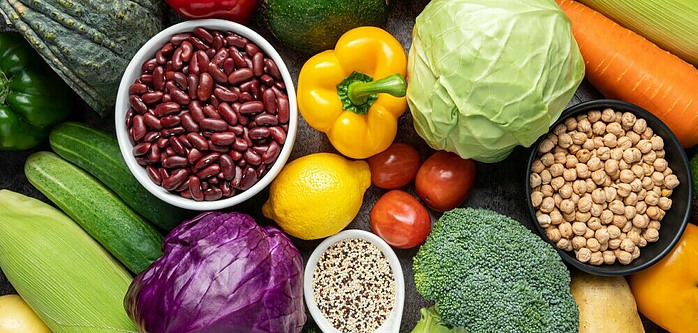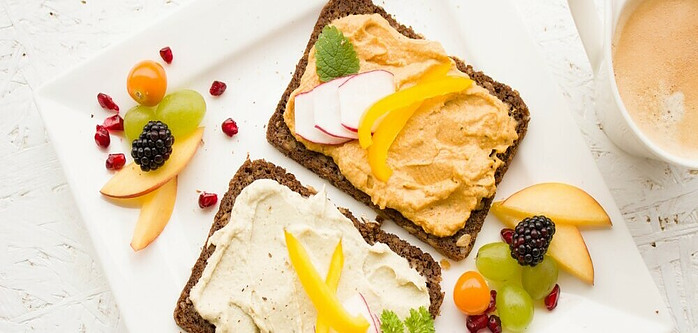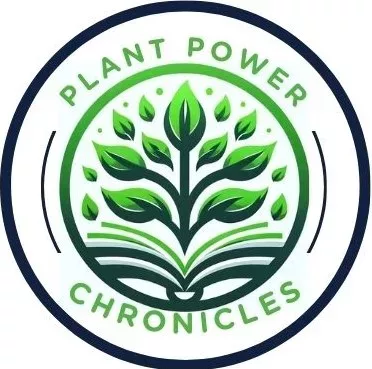
I can remember what it was like getting started with a plant-based diet. I had so many questions and was not sure where to even start. It seemed to be a little overwhelming.
That is why I made this guide. I truly want to help and support your journey. So, without further ado.
I’m going to kick things off by guiding you through the ins and outs of a plant-based diet. It’s a popular term you’ve probably heard tossed around quite a bit, but what does it really mean? Simply put, a plant-based diet focuses on foods primarily from plants.
- Fruits
- Vegetables
- Nuts
- Seeds
- Oils
- Whole grains
- Legumes
- Beans
It’s not about being perfect; it doesn’t mean you are vegetarian or vegan and never eat meat or dairy. Rather, you are proportionately choosing more of your foods from plant sources.
You’re going to find out that it’s not just about losing weight or following a trend; a plant-based diet is also about improving your health and feeling great.
I want to dispel some common myths and shed light on facts so that you feel comfortable and confident about this lifestyle choice. For instance, many people think that a plant-based diet doesn’t provide enough protein or variety, which is far from true.
Transitioning to a plant-based diet can be a positive and health-conscious choice. You’re embracing a lifestyle that is known to improve your overall health, potentially prevent diseases, and even improve mental clarity.
Plus, it’s an environmentally sustainable option. That’s going to include taking part in reducing animal cruelty and acknowledging the ethical issues surrounding our food choices. Talking about a win-win situation, right?
I’m here to help you with making that transition without feeling overwhelmed. As we move through this guide, I’ll be providing you with practical tips, debunking myths, and sharing essential knowledge to set you up for success. Trust me, it’s simpler than it sounds and totally worth the effort.
So now, let’s explore the foundation of a plant-based diet—nutrient-rich foods. These are the powerhouses that’ll fuel your body and support your health journey. Whether you’re a seasoned health enthusiast or taking your first steps into this lifestyle, understanding the abundance of options available is key.
In the next section, I’ll highlight the diversity and benefits of plant-based foods that are loaded with essential nutrients. Gear up! This journey is not just going to benefit your body, but your mind and the planet as well.
Discovering Nutrient-Rich Plant Foods
I’m going to walk you through the garden of plant-based nutrition, a place brimming with vibrant foods that are just as delicious as they are good for you.
Let’s turn the spotlight on the wide array of fruits and veggies, whole grains, legumes, nuts, and seeds. You’re going to find out about their essential roles in your diet and how each one brings a bounty of vitamins, minerals, and antioxidants to the table.

Diving deeper, we’ll explore how swapping out that bag of chips for crisp bell peppers or crunchy carrots isn’t just a trade in texture, it’s an upgrade in nutrition. We’ll look at how the fiber in whole grains like oats and quinoa isn’t just there to help keep things moving along your digestive tract; it also contributes to heart health and helps maintain steady blood sugar levels.
As we talk legumes, think beyond your basic beans. We’re talking chickpeas, lentils, and even soybeans – each a powerhouse of nutrients that pack a punch for your health.
And who could forget nuts and seeds? Just a handful can sprinkle your day with essential fatty acids and proteins.
Lastly, I’ll give you some golden tips for bringing more of these nutrient-rich foods into your daily routine. It’s not about overhauling your diet in one day; it’s about making small, manageable changes that lead to a big impact over time.
Choose something that resonates with you, be it snacking on almonds or sprinkling chia seeds on your breakfast. Remember, your first attempt doesn’t need to be your last – you can always adjust your approach down the road.
The Truth About Proteins in a Plant-Based Diet
🌱 Plant-Powered Proteins 🌱
| Protein Source | Suggested Daily Intake | Nutritional Benefits |
|---|---|---|
| Lentils | 1 cup | Rich in iron and fiber |
| Quinoa | 1 cup | Complete protein source |
| Chickpeas | 1 cup | High in protein and folate |
| Tofu | 150g | Excellent source of calcium |
| Almonds | 1/4 cup | Provides healthy fats and vitamin E |
| Spinach | 2 cups | Packed with iron and antioxidants |
| Chia Seeds | 2 tablespoons | High in omega-3 fatty acids |
If you want to understand plant-based nutrition, protein is the perfect place to start. There’s a persistent question I hear all the time: ‘Can you get enough protein on a plant-based diet?’ Guess what? You absolutely can. Here’s how you do it.
When you combine different plant foods, you create what’s known as a ‘complete protein.’ This means the food provides all the essential amino acids your body needs.
Combining beans with rice or hummus with whole-grain bread are classic examples that bring together complete proteins.
You’re going to find out about plant-based sources that are surprisingly high in protein. Lentils, chickpeas, and various types of beans pack a hefty protein punch.
Quinoa, a seed that we often treat as a grain, is not only high in protein but also is a naturally complete protein.
Don’t worry too much about tracking every amino acid; nature has got your back. So long as you’re eating a varied diet rich in whole foods, your body is going to piece together what it needs. It’s like a puzzle – providing the pieces throughout the day allows your body to assemble the bigger picture. The benefit is clear: a well-rounded diet that supports your bodily functions and keeps you energized.
Securing Essential Nutrients from Plant Sources
When embracing a plant-based diet, there’s a common question I often hear: ‘How do I make sure I’m getting all the essential nutrients?’ It’s crucial to ensure that no nutrient falls through the cracks. In fact, a well-rounded plant-based diet can meet all your nutritional needs, if you know where to look.
Let’s kick things off with B12, a superhero nutrient that’s essential for nerve function and the production of DNA and red blood cells. Since it’s mostly found in animal products, plant-based eaters should turn to fortified foods like plant milks, breakfast cereals, or nutritional yeast. If you’re not getting enough B12 through fortified foods, a B12 supplement should do the trick.
Iron is another puzzle piece that’s vital for your blood and energy levels. Luckily, it’s plentiful in:
- Legumes
- Tofu
- Cashews
- Chia seeds
- Pumpkin seeds
- Quinoa
- Fortified cereals
To boost the iron absorption from these plant sources, simply pair them with vitamin C-rich foods like bell peppers, citrus fruits, or tomatoes in your meals.
What about calcium, you ask? Well, it’s key for bone health, and you can get plenty from plant sources such as:
- Broccoli
- Collard greens
- Kale
- Fortified plant milks
- Almonds
‘Variety’ is your best friend here – make sure to diversify your sources.
Omega-3 fatty acids are often highlighted for their role in heart and brain health.
- Flaxseeds
- Chia seeds
- Walnuts
- Hemp seeds
- Algae-based supplements
Are excellent sources for plant-based diets. Heads up, though — balancing omega-3 and omega-6 levels is important to maximize benefits, so keep an eye on your intake.
Finally, the sunshine vitamin – vitamin D. It’s vital for immune function and bone health. It’s naturally sourced from sunlight, but plant-based eaters in less sunny climes might need to look for fortified foods or consider a vitamin D supplement, particularly in the winter months.
Now, as we look ahead to meal planning, remember that knowing your nutrient sources is half the battle. The next section will guide you on turning these nutrient-packed ingredients into mouth-watering meals.
Ready to take the guesswork out of plant-based meal planning? That’s going to include everything from grocery shopping to putting the final touch on your dishes, so hang tight, and let’s make this a seamless transition.
Plant-Based Meal Planning Made Easy

If you’re new to a plant-based diet, the thought of meal planning might seem a bit daunting. But don’t worry; I’m going to help you get started with some simple strategies that work wonders.
Meal planning doesn’t have to be a chore; in fact, it can be quite enjoyable when you’re armed with the right information and tools.
The first step is to get acquainted with plant-based recipes that are easy to make and packed with flavor. Start with a few basic dishes that you enjoy and gradually expand your repertoire.
There are countless resources available online, including blogs and cooking channels dedicated to plant-based eating, where you can find recipes that range from quick weekday dinners to elaborate weekend feasts.
Next, consider incorporating more plant-based options into your existing meal rotation. For instance, if you love spaghetti, try swapping out the meat sauce for a rich, herb-infused tomato sauce packed with lentils or chunky vegetables.
Or replace the chicken in your favorite curry with chickpeas for a protein-rich alternative that’s just as satisfying.
Meal prepping can be your best friend here, particularly for busy weekdays. Dedicate a portion of your weekend to prepping a variety of veggies, cooking up a big batch of grains like rice or quinoa, and preparing some plant-based proteins like marinated tempeh or tofu.
Store these in the fridge, and you’ll be able to throw together nutritious meals in no time throughout the week.
Finally, keep your meal planning flexible. Allow for variety so you don’t get bored, and remember that it’s okay to switch things around if you find a new recipe you’re excited to try or if you have leftovers that need to be used up.
Flexibility also helps accommodate any surprises that might pop up during your week, making it easy to stay on track with your plant-based goals.
Exploring Plant-Based Protein Alternatives
You’re going to find out about the wonderful world of plant-based proteins. While meat is often touted as a primary source of protein, there’s a treasure trove of options in the plant kingdom that are not only packed with protein but also boast other health benefits.
- First up on the list is tofu, a versatile soy product that can take on any flavor you throw at it. Whether you’re stir-frying, baking, or grilling, tofu can fit the bill.
- Next, we have tempeh, another soy-based powerhouse that’s firmer in texture and boasts a nutty flavor, making it a perfect meat alternative in many dishes.
- Don’t forget about lentils and chickpeas. These legumes are not just protein-rich; they are also full of fiber, helping you feel full and satisfied. They can be turned into soups, stews, salads, or even ground up to make burger patties.
- Let’s talk about quinoa. While many whole grains are good protein sources, quinoa stands out as it contains all nine essential amino acids, just like animal proteins.
I’m not just here to tell you what to eat, but how to enjoy it too. For anyone wary of giving up their beloved meaty favorites, there’s good news: the flavor is in the seasoning, not just the meat. By using the right herbs and spices, you can recreate those familiar flavors you love with plant-based proteins.
Choose something that resonates with you. Maybe you’re a fan of Mexican cuisine; try swapping out meat with black beans in your tacos.
Love Italian food? How about a lentil Bolognese sauce over your pasta? The key is starting with dishes you already enjoy and then experimenting with plant-based proteins as substitutes.
The Positive Impact of Plant-Based Diets on the Planet

You’re going to find out about how what’s on your plate doesn’t just affect you, but the whole planet. This isn’t just about personal health; it’s also about stepping up as stewards of our environment.
When you choose plant-based foods, you’re cutting down on water usage, land strain, and greenhouse gas emissions typically linked with livestock farming. In fact, producing plant-based foods requires significantly less resources compared to animal-based foods.
Consider this: by opting for more beans, grains, and veggies, you’re aiding in the conservation of natural resources. You’re basically voting for the environment with every meal you eat.
And it doesn’t stop there. Animal welfare is another profound consideration. Transitioning to a plant-based diet is a conscious choice that echoes your stand on ethical treatment of animals and reduces your connection to farming practices that may not align with your values.
By now, you’re likely seeing the bigger picture. Your dietary choices have the power to shape a more sustainable and compassionate world.
Good for you, kind to animals, and nourishing for the planet – it’s a win-win-win.
Finding Your Plant-Based Tribe

If you want to make lasting changes to your diet, having a supportive network can be a game-changer. I’m going to talk about the importance of building your plant-based tribe. It’s not just about changing what you eat; it’s also about connecting with people who share your goals and values.
Online communities are thriving with plant-based enthusiasts. There’s a lot of opportunity in these spaces to exchange recipes, share stories, and seek advice. From dedicated forums to social media groups, you can always find someone who’s gone through the same journey and is eager to help.
Local groups and meetups can be equally enriching. Imagine going to a potluck where everyone brings a plant-based dish. You’re going to find out about new foods, gain fresh ideas, and forge friendships all at the same time. In my opinion, the shared experience of eating together creates a unique bond.
I’ve been loving the stories of those who’ve transitioned to a plant-based diet. They are inspiring and often full of practical tips that could make your journey smoother. Don’t worry too much about fitting in immediately; plant-based communities are known for being welcoming and inclusive.
Let’s not forget the power of engaging with these groups. They’re not just there for advice but also for encouragement. Choose something that resonates with you, whether it’s an online challenge, a meetup group, or a cooking class. Your first attempt doesn’t need to be your last, and you can always adjust your approach down the road.
Of course, you are always welcome to be part of our community right here. We are not just a resource, but also a place to share trials and victories. Learn new things, stay up on the latest plant-based trends, and finding a sense of connection.
Conclusion: Embracing a Plant-Based Future
You’re going to find that embracing a plant-based diet is more than just about changing what’s on your plate, it’s about embracing a lifestyle that’s aligned with health-conscious living, environmental stewardship, and ethical considerations.
As you embark on this journey, remember that your choices can have a profound impact not only on your health but also on the world around us.
Don’t worry too much about getting everything perfect from the start. Your first attempt doesn’t need to be your last, and you can always adjust your approach down the road.
Instead, celebrate the small victories — whether that’s learning a new recipe, discovering a local farmers’ market, or enjoying the newfound energy that comes with nutrient-rich meals.
If you still have concerns or questions, I’m here to help you. Consider this article as a steppingstone towards a greener, more compassionate way of living.
- Keep educating yourself
- Experiment with new foods
- Find inspiration in the vibrant plant-based community
Choose something that resonates with you, whether that’s the tantalizing flavors of plant-based cuisine, the desire to reduce your carbon footprint, or the wish to lead a lifestyle that aligns with your values. There’s a lot of opportunity in this space, and taking that initial step is how you’ll unlock it.
I really hope that this guide has illuminated the path for you. Remember, transitioning to a plant-based diet isn’t just a fleeting trend; it’s a substantial move towards a healthier, more sustainable future.
So, what will your first plant-powered meal be? I’d love to hear your feedback and your experiences as you go forward.
If you have any comments or you need a question answered, I am here to help you. Just drop me a line below.

